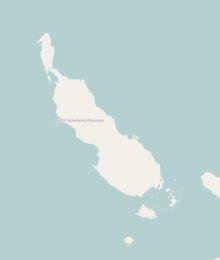Panguna mine
 Copper ore concentrator undergoing construction, c. 1971 | |
| Location | |
|---|---|
 Panguna mine | |
| Autonomous Region of Bougainville | |
| Country | Papua New Guinea |
| Coordinates | 6°18′54″S 155°29′42″E / 6.315°S 155.495°E |
| Production | |
| Products | Copper, gold, silver |
| Type | Open pit |
| History | |
| Opened | 1972 |
| Closed | 1989 |
The Panguna mine is a large copper mine located in the Autonomous Region of Bougainville, in the east of Papua New Guinea. Panguna represents one of the largest copper reserves in Papua New Guinea and in the world, having an estimated reserve of 1 billion tonnes of ore copper and 12 million ounces of gold.[1][2] The mine has been closed since 1989 and has ceased all production.
History[]
The discovery of vast copper ore deposits in Bougainville's Crown Prince Range led to the establishment of the copper mine in 1969 by Bougainville Copper Ltd, a subsidiary of the Australian company Conzinc Rio Tinto of Australia. The mine began production in 1972 with the support of the Papua New Guinea National Government as a 20% shareholder. In contrast to this, the Bougainvilleas received 0.5–1.25% share of the total profit. It provided over 45% of Papua New Guinea's national export revenue and was important to the economy.[3]
The mine had caused devastating environmental issues on the island and the company was responsible for poisoning the entire length of the Jaba River, causing birth defects, as well as the extinction of the flying fox on the island. The Bougainville Copper had set up a system of racial segregation on the island, with one set of facilities for white workers and one set for the locals. This led to an uprising in 1988, led by Francis Ona, a Panguna landowner and the Commander of the Bougainville Revolutionary Army. This ended up causing a civil war in Bougainville, which led to the closure of the mine. Mine production was officially halted on May 15 1989, which led to the complete withdrawal of BCL personnel by March 24, 1990.[4]
Current status[]
The mine was once the world's largest open pit copper gold mine generating over 40% of PNG's GDP. It has remained closed since 1989. This occurred as a result of the conflict between the forces led by Francis Ona, Supreme Commander of the Bougainville Revolutionary Army (BRA) and the Papua New Guinea Defence Force. The 10 year conflict was brutal and resulted in over 20,000 dead. The dispute was essentially a land owners' revolt over getting none of the massive profits generated by the mine. Many of the BRA leaders are the traditional land owners within the mine's lease. Occupation of the entire mine area is by controlling entry at the Morgan's Crossing Checkpoint, which is staffed by armed guards. PNG was supported by Australia and the mines operator, Bougainville Copper Limited ("BCL") (ASX: BOC) in the conflict which sought Bougainville's secession from PNG and an end to the mining on environmental grounds.
The area of Panguna has also been closed off by Panguna landowners, represented by the Meekamui Tribal Government and remains a 'no go zone'. The mine is controlled by the Me'ekamui Tribal Government of Unity and its leaders, President Philip Miriori and Vice President, Phillip Takaung and Stanley Ona, son of Francis Ona. The area is secured by the Me'ekamui Defence Force (formerly the Bougainville Revolutionary Army - the "BRA"). The MDF is led by Commander Moses Pipero
Both President Miriori and Commander Pipero visited and were acknowledged by a feast and speeches, held as part of the historic visit by the Prime Minister of Papua New Guinea on January 29, 2014 to Panguna.

Ore mill at Panguna, Boungainville mine under construction, c. 1971

Shovel at Panguna mine undergoing maintenance, engaged in overburden removal, c. 1971.
See also[]
References[]
- ^ "Panguna Copper Project". portergeo.com. 2012. Retrieved 2013-07-26.
- ^ Doherty, Ben (2020-03-31). "Rio Tinto accused of violating human rights in Bougainville for not cleaning up Panguna mine". The Guardian. ISSN 0261-3077. Retrieved 2020-06-18.
- ^ "Panguna | Papua New Guinea". Encyclopedia Britannica. Retrieved 2020-08-10.
- ^ "History of Panguna mine". Retrieved 15 January 2020.
- Copper mines in Papua New Guinea


